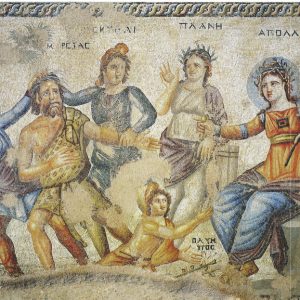After years of research conducted by Prof. Marek T. Olszewski from the UW Faculty of Archaeology, the iconographic program of the famous mosaic from the reception room of the Roman House of Aion in Paphos (Cyprus) has been resolved. The interpretation of the Polish researcher was accepted by scholars of Roman iconography as adequate and precise.
A Polish archaeological mission conducted by Prof. W. A. Daszewski in 1983, unearthed a room (68 m2) with an enigmatic figural mosaic (16 m2) in ancient Paphos. The overall decoration of the floor indicated that this room should be considered as dining room (triclinium), where the meal could be a pretext for discussion of multiple topics among the hosts. This hall which is found in an independent part of the house, was hired most likely by a group of people such as an association using it regularly; the hosts entered through an independent entrance directly from the street. The figural mosaics consisted of five rectangular panels in 2-1-2 order. All panels were decorated with mythological scenes as follows:
- Leda with Zeus in the form of a swan;
- Infant Dionysus in Hermes’ lap being given to the Nymphs (nannies), Anatrophe (the god’s first caretaker woman), and Tropheus (his first teacher) on the Mount Nysa;
- The central panel depicts the competition between Kassiopea, queen of Ethiopia (and mother of Andromeda), and the Nereids (sea goddesses) and the gods’ judgement, deciding which is the most beautiful; the queen won;
- A Dionysian procession, with the god surrounded by maenads and satyrs;
- The judgement of Marsyas, losing the music contest to Apollo.
The program of the mosaic has been differently interpreted by specialists, disregarding the overall narrative and the meaning of five panels, its purpose and to whom it was created. The mosaics are quite accurately dated to after AD 318, based on a coin found in the mortar. In this period the Roman power and administration rejected the pagan religion and converted to Christianity. It was a period of numerous confrontations and polemics between conservative adherents of Roman religions and the new monotheistic worshipers.
According to Prof. Olszewski, four stages are distinguished:
- An allegorical narrative, identified what story could be about it and in what order it should be interpreted; what mosaic panel starts this story and which images sequentially continue the narrative logically;
- Identifying the logical order in which the panels were arranged; this indicates an allegorical and universal story of a religious human being (a pagan) in five episodes: (a) the conception of a child consisting of a body and a soul (Zeus and Leda); (b) followed by nurturing the spirit of a pagan faith (Dionysus among the educators); and (c) living according to the pagan faith (Dionysiac procession). (d) If a person does not respect gods and shows a lack of piety towards them, he will be consequently punished (Apollo and Marsyas), and (e) if he is religious and pious, he (his soul) will attain eternal life through apotheosis (the victory of Cassiopeia over the Nereids);
- The third stage was the understanding and placing the narrative in a historical, religious and philosophical context. Prof. Olszewski shows that the pagan mosaic illustrate an anti-Christian polemic (in images) as were frequent particularly in the texts of pagan writers in the period, with the increasing dominance of Christianity;
- The last stage was an intellectual atmosphere in which the mosaic was created, thus obeying the rules of rhetoric: allegory, analogy, personification, and – what was the fundamental conclusion – antithesis. All these topics were used in rhetorical arts, however they had a wide impact on other domains, including the visual arts. The mosaic follows the principles of a rhetorical antithesis which targets the Christianity and particularly the Passion of Christ. Followers of the philosophical and religious movement in the 3rd-4th c. AD (Neoplatonists) intensified anti-Christian polemics.
The mosaic of the House of Aion in Paphos is not the only case showing polemical attitude towards the followers of the new religion. Two other such polemical mosaics can be seen in the nearby Syria – Philipopolis (a cosmological mosaic) and another in Apamea (Socrates among the sages).





